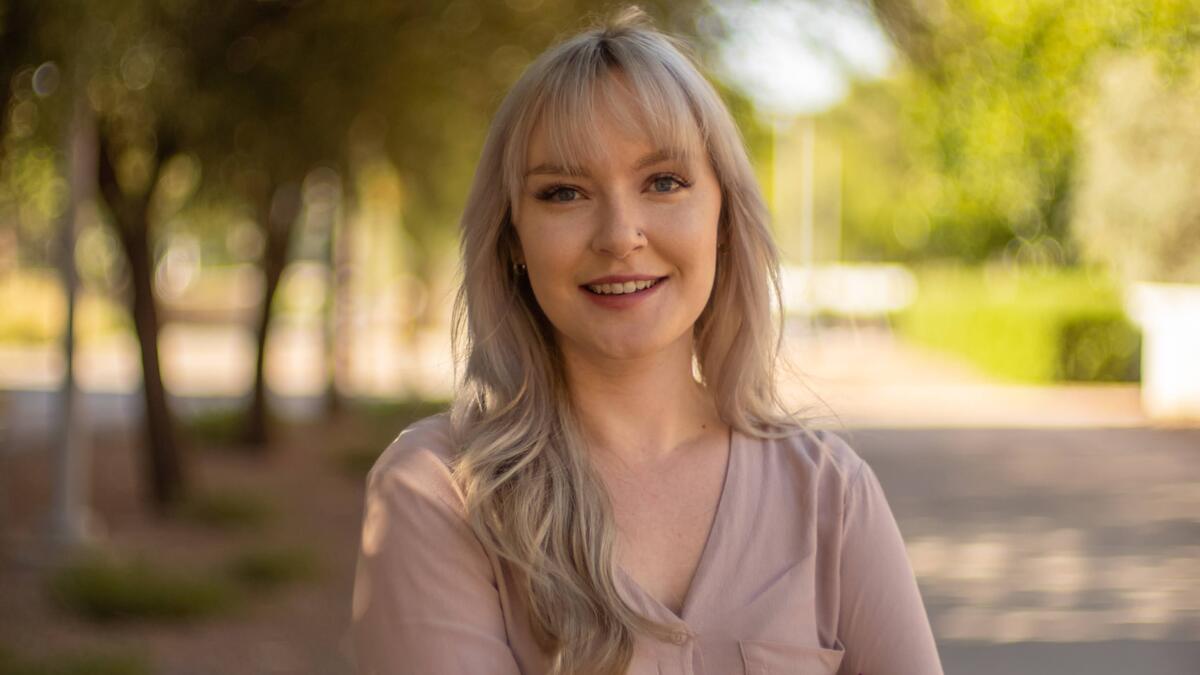Helping maltreated children in foster care

Austin Blake, a doctoral student in the ASU Department of Psychology, was recently named a National Research Service Award Fellow by the National Institute of Child Health and Human Development for her project "Estimating the Impact of Out-of-Home Placement on Health Risk Behavior in Adolescents Exposed to Maltreatment: An Advanced Causal Inference Approach." Photo by Robert Ewing
Each year, approximately 250,000 children enter the foster care system, and at any given time, upwards of 400,000 children are in the system. Additionally, according to the Arizona Department of Child Safety, there are nearly five children in care for every licensed foster family.
A graduate in Arizona State University's clinical psychology training program hopes to find new ways to help those children and families at the most pivotal time.
Austin Blake, a doctoral student in the Department of Psychology, was recently named a National Research Service Award Fellow by the National Institute of Child Health and Human Development for her project "Estimating the Impact of Out-of-Home Placement on Health Risk Behavior in Adolescents Exposed to Maltreatment: An Advanced Causal Inference Approach."
The award provides funding for her research and allows Blake to receive additional training necessary for her research career, including in the areas of child welfare research and advanced statistical methods.
“I study the link between parent and child separation and health risk behaviors. One context in which separation occurs frequently is through maltreatment — both abuse and neglect,” Blake said. “Prior to coming to ASU, I studied kids who were adopted from foster care, and oftentimes they entered foster care because of parental addiction and other things like that. Once coming here, I became really interested in just how substance use and other health risk behaviors develop across adolescence and adulthood.”
Blake wants to find out if removing the child from the home increases or decreases the risk for later adverse health risks behaviors.
“The time period when a child is removed from the home and their guardians is a crucial window of time. I believe that future interventions should target that time period in order to reduce the long-term impacts of the experience,” Blake said.
Using a public data set of maltreated children, Blake will be using an advanced causal inference statistical method to determine more specific differences between children who are removed from the home versus those that remain.
“We're looking at what mechanisms might underlie the effect of out-of-home placement on later health risk behavior. Through this research, we can identify factors that we can target for that population. For instance, we might want to focus on adolescents’ increases in depression or anxiety, or perhaps their relationships with parents. Being able to identify causes at this stage can prevent those increases in health risk behavior while in foster care,” Blake said.
What makes Blake’s research different from what has been done before is that she is using advanced statistical methods to account for confounding variables so that she can most accurately estimate the effect of out-of-home placement on health risk behaviors. In populations like this, it is impossible and unethical to run randomized research on placing children in foster care, so being able to identify potential areas for intervention can be difficult.
Additionally, rather than looking at younger children, her research is focusing on adolescents. The adolescent period between ages 13–18 is a turning point that redirects developmental trajectories of health risk behavior, such as initiating substance use and sexual behavior. Blake wanted to focus on this age group as well because when compared with younger children, teenagers placed in foster homes experience greater placement instability and greater difficulty adjusting to new caregivers or guardians.
Blake’s two primary co-sponsors at ASU are Regents Professors Laurie Chassin and David MacKinnon, considered leaders in the fields of health risk behaviors and statistical mediation, respectively. Their mentorship has helped shape how Blake looks at statistical data and applies it to real-life situations, such as improving the foster care system.
“Throughout my academic career, I've been working with Dr. Chassin on projects that broadly look at how substance use develops and the etiology where it comes from. Specifically, I've been looking at how parent-child separation may impact those trajectories,” Blake said. “This is such important research because there are really far-reaching impacts, such as the intergenerational risk for substance use.”
Data are from the National Survey of Child and Adolescent Wellbeing I (NSCAW-I), a large longitudinal, national probability sample of 6,228 children (ages 0–14 at baseline) who were investigated for child maltreatment between October 1999 and December 2000.
More Science and technology

ASU-led space telescope is ready to fly
The Star Planet Activity Research CubeSat, or SPARCS, a small space telescope that will monitor the flares and sunspot activity…

ASU at the heart of the state's revitalized microelectronics industry
A stronger local economy, more reliable technology, and a future where our computers and devices do the impossible: that’s the…

Breakthrough copper alloy achieves unprecedented high-temperature performance
A team of researchers from Arizona State University, the U.S. Army Research Laboratory, Lehigh University and Louisiana State…

